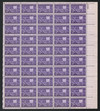
1944 3c 50th Anniversary of Motion Pictures
# 926 - 1944 3c 50th Anniversary of Motion Pictures
$0.35 - $25.00
Â
U.S. #926
3¢ Motion Pictures
3¢ Motion Pictures
Issue Date: October 31, 1944
City: Hollywood, CA; New York, NY
Quantity: 53,479,400
Printed by: Bureau of Engraving and Printing
Printing Method: Rotary Press
Perforations: 11 x 10.5
Color: Deep violet
City: Hollywood, CA; New York, NY
Quantity: 53,479,400
Printed by: Bureau of Engraving and Printing
Printing Method: Rotary Press
Perforations: 11 x 10.5
Color: Deep violet
U.S. #926 commemorates the 50th anniversary of motion pictures. Debuting in 1895, the motion picture greatly enriched peoples lives. Often, troops stationed overseas were shown currently released movies to help keep them in good spirits. The image of troops watching a film was selected for this stamp to show the impact motion pictures had on the nation during the war. Many movies of the era were produced to raise morale, while others served as informational films, educating the public and troops on the war.
Â
U.S. #926
3¢ Motion Pictures
3¢ Motion Pictures
Issue Date: October 31, 1944
City: Hollywood, CA; New York, NY
Quantity: 53,479,400
Printed by: Bureau of Engraving and Printing
Printing Method: Rotary Press
Perforations: 11 x 10.5
Color: Deep violet
City: Hollywood, CA; New York, NY
Quantity: 53,479,400
Printed by: Bureau of Engraving and Printing
Printing Method: Rotary Press
Perforations: 11 x 10.5
Color: Deep violet
U.S. #926 commemorates the 50th anniversary of motion pictures. Debuting in 1895, the motion picture greatly enriched peoples lives. Often, troops stationed overseas were shown currently released movies to help keep them in good spirits. The image of troops watching a film was selected for this stamp to show the impact motion pictures had on the nation during the war. Many movies of the era were produced to raise morale, while others served as informational films, educating the public and troops on the war.








